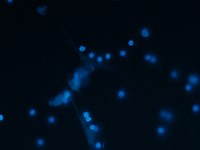
Photo from wikipedia
Candida albicans is the most common pathogen causing clinical Candida infections. Neutrophils are a key member of the host innate immunity that plays an essential role in clearing invading C.… Click to show full abstract
Candida albicans is the most common pathogen causing clinical Candida infections. Neutrophils are a key member of the host innate immunity that plays an essential role in clearing invading C. albicans. In addition to the well-known defensive approaches such as phagocytosis, degranulation, and reactive oxygen species production, the formation of neutrophil extracellular traps (NETs) has also become an important way for neutrophils to defend against various pathogens. C. albicans has been reported to be capable of activating neutrophils to release NETs that subsequently kill fungi. The induction of NETs is affected by both the morphology and virulence factors of C. albicans, which also develops specific strategies to respond to the attack by NETs. Our review specifically focuses on the mechanisms by which C. albicans triggers NET formation and their subsequent interactions, which might provide meaningful insight into the innate immunity against C. albicans infection.
Journal Title: Frontiers in Immunology
Year Published: 2022
Link to full text (if available)
Share on Social Media: Sign Up to like & get
recommendations!